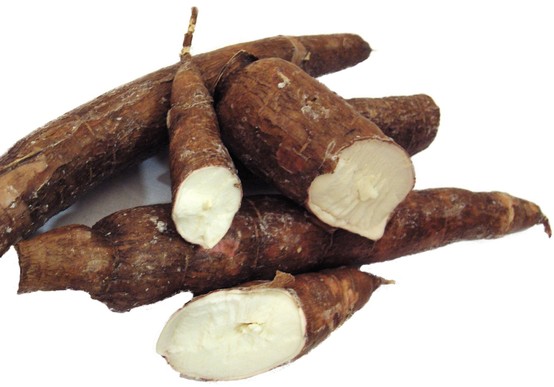
Cassava is the most popular starch tuber in Nigeria. One of the reasons is because it’s the source of one of the nation’s major staple food: garri. Beyond garri, foods like abacha and fufu are popular all around the nation, and are all produced from the cassava. With the current president, Goodluck Jonathan, now endorsing cassava bread – an already popular and enjoyable meal around the world – we’re in for more discoveries about this essential tuber and the many variations in which it can be prepared.
Cassava? Do you mean yuca?
If you asked for cassava in South America, you’ll be given a tuber of yuca—that’s what it’s called there. It’s known as manioc in Africa, and by another popular name – tapioca – which is actually of Brazilian origin. That’s the name for cassava in the language of the Tupi peoples of Brazil.
Cassava comes in two varieties. Sweet cassava, (Manihot dulcis) is the variety available straight in supermarkets and is prepared the same way as other tubers like potato and yam—boiled, fried or mashed. Bitter cassava (Manihot esculenta) cannot be eaten raw but because of its high starch content it is highly processed, dried to a starchy, powdery (or pearly) extract now called tapioca, while its fermented, flaky version is named garri.
Sweet cassava is extensively cultivated as an annual crop in tropical and subtropical regions for its edible starchy, tuberous root, a major source of carbohydrates. It differs from another similarly-spelled yuca, an unrelated fruit-bearing shrub in the Asparagaceae family.

Now for some Cassava history
Cassava is the third-largest source of food carbohydrates in the tropics. It is a major staple food in the developing world, providing a basic diet for around 500 million people. It is also one of the most drought-tolerant crops, capable of growing on marginal soils.
Farmers would rather cultivate the bitter varieties of the cassava, (Manihot esculenta), than the sweet because they deter pests and animals. The more toxic varieties of Cassava are a fall-back resource (a “food security crop”).
Bitter cassava gets the classification “bitter” because of the presence of prussic acid in its roots, and this occurs in sufficient quantities enough to be deadly. Sweet manioc varieties can be boiled straight and eaten. Some cultivated varieties with a lesser acid content, called sweet cassava, are edible raw and can be used for fodder. Cassava roots are also fermented to make an alcoholic beverage, and are used for cotton sizing and laundry starch.
Cassava leaves are a good source of protein (rich in lysine), but deficient in the amino acid methionine and possibly tryptophan.
Economic importance of Cassava
World production of cassava root was estimated to be 184 million tonnes in 2002, rising to 230 million tonnes in 2008 (FAO). Nigeria is the world’s largest producer of cassava. However, based on the statistics from the FAO of the United Nations, Thailand is the largest exporting country of dried cassava, with a total of 77% of world export in 2005. The second-largest exporting country is Vietnam, with 13.6%, followed by Indonesia (5.8%) and Costa Rica (2.1%).
Cassava is an important source of food in the tropics. The cassava plant gives the highest yield of carbohydrates per cultivated area among crop plants, except for sugarcane and sugar beets. Cassava also plays a particularly important role in agriculture in developing countries, especially in sub-Saharan Africa, because it does well on poor soils and with low rainfall, and because it is a perennial that can be harvested as required. It also offers flexibility to resource-poor farmers because it serves as either subsistence or a cash crop.
No continent depends as much on root and tuber crops in feeding its population as does Africa. In the humid and sub-humid areas of tropical Africa, it is either a primary staple food or a secondary food.

Uses of Cassava
Culinary
- Sweet Cassava. The soft-boiled root has a delicate flavour and can be used in place of boiled potatoes: as an accompaniment for meat dishes, or made into purées, dumplings, soups, stews, gravies, etc. Deep fried (after boiling or steaming), it can replace fried potatoes, with a distinctive flavour.
- Fufu. Fufu is made from the starchy cassava-root flour by first pounding cassava in a mortar to make flour, which is then sifted before being put in hot water to become fufu.
- Tapioca. A flavorless, starchy ingredient produced from treated and dried cassava (manioc) root, is used in cooking.
- Garri. This is a creamy-white, granular flour with a slightly sour, fermented flavor from fermented, gelatinized fresh cassava tubers. Garri soaking is a very affordable delicacy in Nigeria. One can simply soak garri flour in cold water, add a bit of sugar and roasted groundnut (peanut) to taste, and add whatever quantity of evaporated milk one desires. You may prepare your soaked garri with coconut water instead, to add some flavour.
Biofuel
In many countries, significant research has begun to evaluate the use of cassava as an ethanol biofuel feedstock. This will be equivalent to a substitute of 10 million tonnes of petroleum. As a result, cassava (tapioca) chips have gradually become a major source for ethanol production.
Animal feed
Cassava is used worldwide for animal feed, as well. Cassava hay is produced at a young growth stage at three to four months, harvested about 30–45 cm above ground, and sun-dried for one to two days until it has final dry matter of less than 85%. The cassava hay contains high protein (20-27% crude protein) and condensed tannins (1.5-4% CP). It is used as a good roughage source for dairy or beef cattle, goats, and sheep by either direct feeding or as a protein source in the concentrate mixtures.
Now you know your cassava a little better, some of the delicious variations in which it can be prepared, and how this tuber is essential to food production, especially in Africa.


